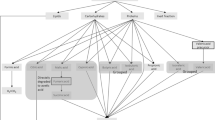Abstract
This study derives a mathematical description of the kinetics of phenol degradation with sulfate reduction by an anaerobic mixed-culture biofilm on an inert medium. The model incorporates the mechanisms of diffusive mass transport and Monod kinetics. It is solved using both the orthogonal collocation method and Gear’s method. Sensitivity studies were performed to investigate the dependence of process dynamics on the model parameters pertaining to biokinetic parameters, liquid film mass transport, and the biofilm and reactor operational parameters. Sensitivity analysis quantifies the magnitude of the effect of each variable on the simulated results using the least-square method. The transient-state process dynamics are sensitive to the biokinetic parameters including yield coefficient of phenol-utilizing bacteria, Monod maximum specific utilization rate of phenol, and the decay coefficient of phenol-utilizing bacteria. The process efficiency is also sensitive to biofilm parameters such as biofilm density of phenol-utilizing bacteria and initial biofilm thickness , and to such operational parameters as the influent phenol concentration and the hydraulic retention time of the system. The process dynamics are relatively insensitive to mass transport parameters, including the film transfer coefficient of phenol and the diffusion coefficient of phenol. Sensitivity analysis of the process dynamics to model parameters helps determine how to alter process conditions to enhance removal efficiency.









Similar content being viewed by others
Abbreviations
- A :
-
total surface area of the media (L 2)
- b a :
-
decay coefficient of SRB (1/T)
- b p :
-
decay coefficient of PUB (1/T)
- b sa :
-
shear-loss coefficient of SRB (1/T)
- b sp :
-
shear-loss coefficient of PUB (1/T)
- D fa :
-
diffusion coefficient of acetate in the biofilm (L 2/T)
- D fp :
-
diffusion coefficient of phenol in the biofilm (L 2/T)
- D fu :
-
diffusion coefficient of sulfate in the biofilm (L 2/T)
- f :
-
conversion efficiency of phenol to acetate (M s /M s )
- HRT:
-
hydraulic retention time
- k a :
-
Monod maximum specific utilization rate of acetate by SRB (1/T)
- k fa :
-
liquid film transfer coefficient of acetate (L/T)
- k fp :
-
liquid film transfer coefficient of phenol (L/T)
- k fu :
-
liquid film transfer coefficient of sulfate (L/T)
- K ip :
-
inhibition constant of phenol (M s/L 3)
- k p :
-
Monod maximum specific utilization rate of phenol by PUB (1/T)
- K sa :
-
Monod half-velocity coefficient of acetate (M s /L 3)
- K sp :
-
Monod half-velocity coefficient of phenol (M s/L 3)
- K su :
-
Monod half-velocity coefficient of sulfate (M s /L 3)
- PUB:
-
phenol-utilizing bacteria
- Q :
-
flow rate of the influent (L 3/T)
- r sa :
-
utilization rate of acetate by SRB in biofilm (M s /L 3 − T)
- r sn :
-
net generation rate of acetate (M s /L 3 − T)
- r sp :
-
utilization rate of phenol by PUB in biofilm (M s /L 3 − T)
- S ba :
-
concentration of acetate in the bulk liquid (M s /L 3)
- S ba0 :
-
concentration of acetate in the influent (M s /L 3)
- S bp :
-
concentration of phenol in the bulk liquid (M s /L 3)
- S bp0 :
-
concentration of phenol in the influent (M s /L 3)
- S bu :
-
concentration of sulfate in the bulk liquid (M s /L 3)
- S bu0 :
-
concentration of sulfate in the influent (M s /L 3)
- S fa :
-
concentration of acetate in the biofilm (M s /L 3)
- S fp :
-
concentration of phenol in the biofilm (M s /L 3)
- S fu :
-
concentration of sulfate in the biofilm (M s /L 3)
- S l :
-
concentration of sulfide in the effluent (M s /L 3)
- SRB:
-
sulfate-reducing bacteria
- S sp :
-
phenol concentration at liquid/biofilm interface (M s /L 3)
- S su :
-
sulfate concentration at liquid/biofilm interface (M s /L 3)
- t :
-
time (T)
- V :
-
volume of the reactor (L 3)
- X ba :
-
concentration of SRB in the bulk liquid (M x /L 3)
- X bp :
-
concentration of PUB in the bulk liquid (M x /L 3)
- X fa :
-
biofilm density of SRB (M x /L 3)
- X fp :
-
biofilm density of PUB (M x /L 3)
- Y a :
-
yield coefficient of SRB (M x /M s )
- Y p :
-
yield coefficient of PUB (M x /M s )
- z f :
-
radial distance in biofilm (L)
- α:
-
conversion factor for reduction of sulfate to sulfide (M s /M s )
- γ:
-
stoichiometric coefficient for sulfate utilization (M s /M s )
- ε:
-
porosity of the reactor (dimensionless)
References
González, G., Herrera, M. G., García, M. T., & Peńa, M. M. (2001). Biodegradation of phenol in a continuous process: comparative study of stirred tank and fluidized-bed bioreactor. Bioresource Technology, 76, 245–251.
Lin, S. H., & Chuang, T. S. (1994). Combined treatment of phenolic wastewater by wet air oxidation and activated sludge. Technol Environ Chem, 44, 243–258.
Singlenton, I. (1994). Microbial metabolism of xenobiotics: fundamental and applies research. Journal of Chemical Technology and Biotechnology, 59, 9–23.
Gupta, A., Flora, J. R. V., Gupta, M., Sayles, G. D., & Suidan, M. T. (1994). Methanogenesis and sulfate reduction in chemostats–I. Kinetic studies and experiments. Water Research, 28, 781–793.
Wang, S. J., & Loh, K. C. (1999). Modeling the role of metabolic intermediates in kinetics of phenol biodegradation. Enzyme and Microbial Technology, 25, 177–184.
Wang, Y. T., Suidan, M. T., & Rittman, B. E. (1986). Anaerobic treatment of phenol by an expanded-bed reactor. Journal Water Pollution Control Federation, 58, 227–233.
Hirata, A., Noguchi, M., Takeuchi, N., & Tsuneda, S. (1998). Kinetics of biological treatment of phenolic wastewater in three-phase fluidized bed containing biofilm and suspended sludge. Water Science and Technology, 38, 205–212.
Yoda, M., Kitagawa, M., & Miyaji, Y. (1987). Long-term competition between sulfate-reducing and methane-producing bacteria for acetate in anaerobic biofilm. Water Research, 21, 1547–1556.
Pirbazari, M., Ravindran, V., Badriyha, B. N., & Kim, S. H. (1996). Hybrid membrane filtration process for leachate treatment. Water Research, 30, 2691–2706.
Maree, J. P., Hulse, G., Dods, D., & Schutte, C. E. (1991). Pilot plant studies on biological sulphate removal from industrial effluent. Water Science and Technology, 23, 1293–1300.
Law, H. E. M., Lewis, D. J., McRobbie, I., & Woodley, J. M. (2008). Model visualization for evaluation of biocatalytic processes. Food and Bioproducts Processing, 86, 96–103.
Sayar, N. A., Chen, B. H., Lye, G. J., & Woodley, J. M. (2009). Modelling and simulation of a transketolase mediated reaction: sensitivity analysis of kinetic parameters. Biochemical Engineering Journal, 47, 1–9.
Chang, H. T., & Rittmann, B. E. (1987). Mathematical modeling of biofilm on activated carbon. Environmental Science & Technology, 21, 273–279.
Lens, P. N., Depoorter, M. P., Cronenberg, C. C., & Verstraete, W. H. (1995). Sulfate reduction and methane producing bacteria in anaerobic wastewater treatment systems. Water Research, 29, 871–880.
Young, L. Y., & Rivera, M. D. (1985). Methanogenic degradation of four phenolic compounds. Water Research, 19, 1325–1332.
Wang, Y. T., Suidan, M. T., Pfeffer, J. T., & Najam, I. (1989). The effect of concentrations of phenols on their batch methanogenesis. Biotechnology and Bioengineering, 33, 1353–1357.
Abuhamed, T., Bayraktar, E., Mehmetoğlu, T., & Mehmetoğlu, Ű. (2004). Kinetics model for growth of Pseudomonas putida F1 during benzene, toluene and phenol biodegradation. Process Biochemistry, 39, 983–988.
Rittmann, B. E., & McCarty, P. L. (1981). Substrate flux into biofilm of any thickness. Journal of Environmental Engineering ASCE, 107, 831–850.
Bakti, N. A. K., & Dick, R. I. (1992). A model for a nitrifying suspended-growth reactor incorporating intraparticle diffusion limitation. Water Research, 26, 1681–1690.
Finlayson, B. A. (1972). The method of weighted residuals and variational principles. New York, N. Y.: Academic Press.
Crank, J. (1975). The mathematics of diffusion (2nd ed.). London, United Kingdom: Oxford University Press.
Hsien, T. Y., & Lin, Y. H. (2005). Biodegradation of phenolic wastewater in a fixed biofilm reactor. Biochemical Engineering Journal, 27, 95–103.
Vinod, A. V., & Reddy, G. V. (2005). Simulation of biodegradation process of phenolic wastewater at higher concentrations in a fluidized-bed bioreactor. Biochemical Engineering Journal, 24, 1–10.
Lin, Y. H., & Lee, K. K. (2001). Verification of anaerobic biofilm model for phenol degradation with sulfate reduction. Journal of Environmental Engineering ASCE, 127, 119–125.
Liang, C. H., & Chiang, P. C. (2007). Mathematical model of the non-steady-state adsorption and biodegradation capacities of BAC filters. Journal of Hazardous Materials, 139, 316–322.
Liang, C. H., Chiang, P. C., & Chang, E. E. (2007). Modeling the behaviors of adsorption and biodegradation in biological activated carbon filters. Water Research, 41, 3241–3250.
Acknowledgments
This research was supported in part by a grant from National Science Council of the Republic of China (Taiwan) under Contract No. NSC 98-2221-E-166-001-MY2. Ted Knoy is appreciated for his editorial assistance.
Author information
Authors and Affiliations
Corresponding author
Rights and permissions
About this article
Cite this article
Lin, YH., Wu, CL. Sensitivity Analysis of Phenol Degradation with Sulfate Reduction Under Anaerobic Conditions. Environ Model Assess 16, 213–225 (2011). https://doi.org/10.1007/s10666-010-9243-1
Received:
Accepted:
Published:
Issue Date:
DOI: https://doi.org/10.1007/s10666-010-9243-1




